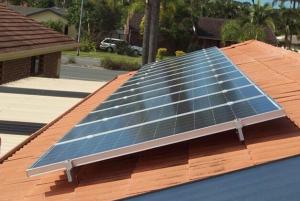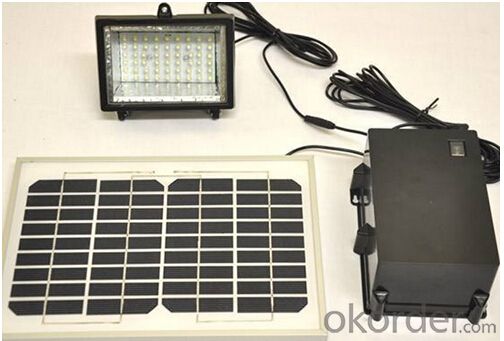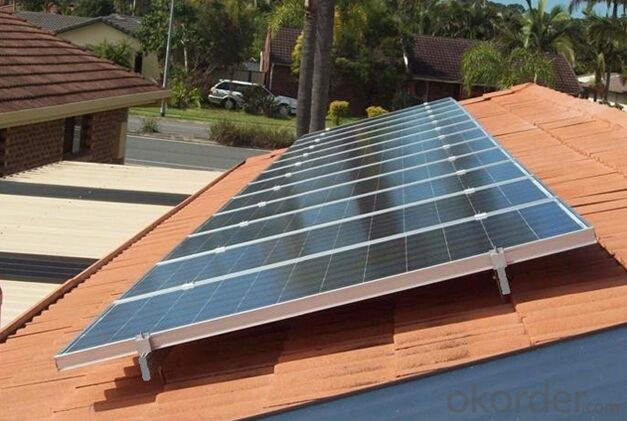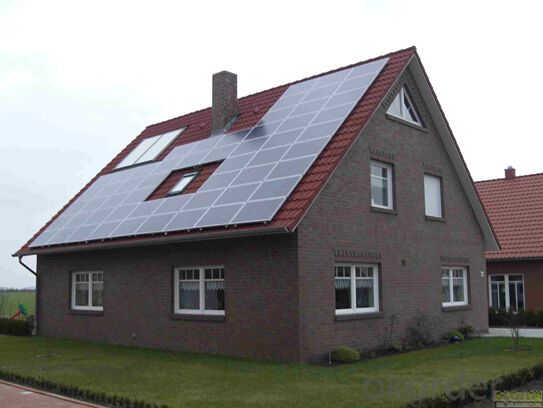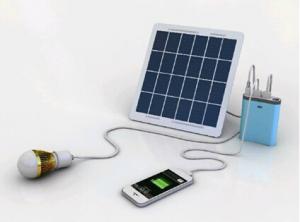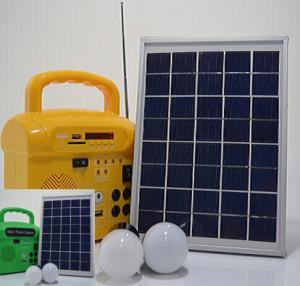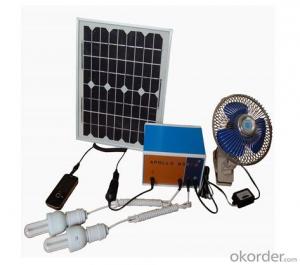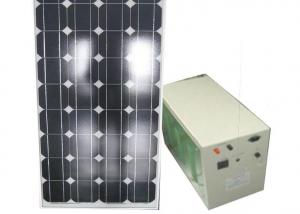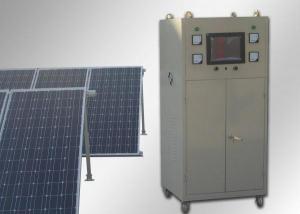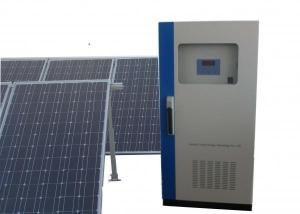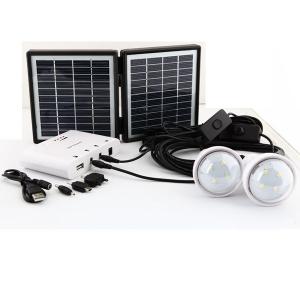CNBM Solar Home System Roof System Capacity-60W
- Loading Port:
- China Main Port
- Payment Terms:
- TT or LC
- Min Order Qty:
- 100 pc
- Supply Capability:
- 10000 pc/month
OKorder Service Pledge
OKorder Financial Service
You Might Also Like
Introduction of our company
We are the first solar racking system developer in China, who committed to solar racking system R&D, producing and marketing for about 10 years. We were the OEM for Sunpower, and are one of the largest rooftop solar racking system supplier in Japan and Australia now.
We are persisting the path of specialization, scale and internationalization development. We have been imported the international advanced technology equipment for manufacturing , assembling and testing. Frontier solar racking system is with own patents. The dynamic wind resistance reliability of our racking system can up to 270km/h. Therefore, superior product quality with more than 25 years' durability and perfect after-sale service have earned us a high reputation in PV industry worldwide.
Working Principle of Solar Roof System
The stand alone Solar Home System is an off-grid solar system which uses batteries to store the solar energy. Stand alone solar system solutions design for those who are not able or willing to connect to electricity grid.
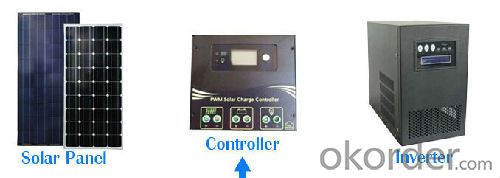
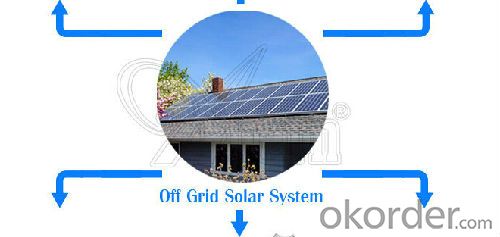

Specification of Solar Home System
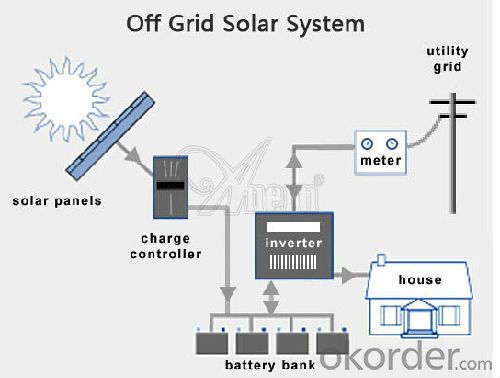
Product Features of Solar Home System
1. AVR Functions:AC145V-275V(input),AC198V-242V (output)
2. 400W continuous, standard and stable pure sine wave
3. Adopts CPU control technique
4. Integrated with inverter, solar controller inside.
5. PV priority mode or AC priority model is identified and swithched automatically
6. Choose the charging current based on the configured capacity of the battery
7. LCD display
8. Wide input range
9. Auto city power switch function, All-around protection, self-recovery and unattended operation.
10. Frequency auto adaptive
11. The system will act as UPS(charge from Grid electricity and automatic supply power when Grid cut off
12. Unattended and intelligent monitoring RS232 (optional)
13. Solar engergy and utility power complementary functions:
*The system can provide electricity produced by solar energy to loads directly.It can auotmatically select the solar energy or utility power as power source according to the change of sunshine, and the work mode will be chosen and switched automatically.
*The systems can automatically select the solar energy or utility power to charge the battery according to the state of the sunlight and battery voltage. AC by pass without charging function is available.
*The systems can automatically identify the state of day and night, and interactive switches between AC mode and inverting mode at night.
Advantage of Our Solar Home System
1. solar power system operation can automatically control and manual control modes.
2. Easy installation, energy saving (saving coal and petroleum resources, reduce pollution / noise emissions); do not need to lay long-distance transmission lines, do not build large substation, system stability, less maintenance, low maintenance cost, daily / each month / year electricity clearly visible, and can be entered into the computer record.
This solar system configuration is for reference. It can be adjusted based on actual condition and requirement. All parts have been tested and proven in actual operation with enough reliability and stability. It’s suggested to source whole system as a pack from us to guarantee the system compatibility.
Terms and Conditions
1. Trade terms: FOB Shanghai
2. Payment terms: 30% T/T, balanced before shipment/ LC at sight before shipment. Actual Terms can be negotiated for big order.
3. Package: Exported standard package suitable for tough handling and sea transport.
4. Delivery: Goods to be ready within 10~30 days depending on order quantity.
5. Warranty: 10 years for solar panel, 2 years for controller/inverter/battery.
FAQ
Q1. Can we design packaging?
Yes, but there is with quantity limitation. For 10,000 pcs, we will make the packing free for the client, and if less than 10,000 pcs, we can talk, the package is free or little money will be charged.
Q2. Can we add our logo on products?
Yes, there are several ways to do this. We can put the label of your logo on the products or make the silk print of your logo on the products. It is free.
Q3. can we customize product?
OEM and ODM are welcomed from Anern. We have rich experiences in this area.
Q4. What is your company return policy?
If we Anern breaks the contract of any agreement on price, quality and any other terms and conditions on the contract, the buyer can return the goods back to us and we will send the money back to buyers. Force majeure and god act are excepted.
Q5. What is your main product line is made?
LED street light and solar street lighting system, LED high bay light, LED flood light, LED tube light, bulb light, panel light, ceiling and down lights, all kinds of indoor lighting and outdoor lighting are available.
Q6.If I have a question I would like advice on how to contact you?
The best way is by e-mail. Tel, wechat, whatsapp, skype, contact us on our website online service worker are good ways to reach us also.
Q7. What will you provide services?
Solution providing, engineering, system design, best products suggestion, quality control, delivery, after sale service and many others. You can get our feedback during 24 hours.
- Q: Can solar energy systems be used for desalination?
- Yes, solar energy systems can be used for desalination. Solar desalination involves using solar energy to power the desalination process, typically through either solar thermal or solar photovoltaic technologies. This renewable energy source can be harnessed to heat water or generate electricity, which can then be utilized to remove salt and other impurities from seawater or brackish water, making it suitable for drinking or agricultural purposes. Solar desalination offers a sustainable and environmentally friendly solution to address water scarcity issues in regions with abundant sunlight.
- Q: How do solar energy systems contribute to reducing peak demand on the electrical grid?
- Solar energy systems contribute to reducing peak demand on the electrical grid by generating electricity during the day when demand is highest. This reduces the need for additional power from traditional sources during peak hours, which helps to stabilize the grid and prevent potential blackouts. Additionally, solar energy systems can also feed excess generated electricity back into the grid, further alleviating peak demand and reducing strain on the electrical infrastructure.
- Q: Can solar energy systems be used in areas with high levels of dust?
- Yes, solar energy systems can still be used in areas with high levels of dust. However, the efficiency of the solar panels may be affected as dust accumulation on the panels reduces their ability to absorb sunlight. Regular cleaning and maintenance can help mitigate this issue and ensure optimal performance of the solar energy system.
- Q: Can solar energy systems be installed on recreational vehicles?
- Yes, solar energy systems can be installed on recreational vehicles. These systems are specifically designed to provide power to RVs and can help owners generate electricity for appliances, lighting, and other electrical needs while on the road or camping.
- Q: Can solar energy systems be used for powering off-grid eco-farms?
- Yes, solar energy systems can be effectively used for powering off-grid eco-farms. These systems can generate electricity through photovoltaic panels, storing excess energy in batteries for use during cloudy or dark periods. By harnessing the abundant sunlight, off-grid eco-farms can become self-sufficient and sustainable, reducing their reliance on traditional power sources and minimizing their environmental impact.
- Q: Can solar energy systems be used in areas with limited government support?
- Yes, solar energy systems can be used in areas with limited government support. In fact, solar energy is a viable and sustainable option for regions that lack government incentives or financial aid. The decreasing costs of solar technology and the availability of off-grid systems make it feasible for individuals, communities, and businesses to adopt solar energy independently. Additionally, with the advancement of innovative financing models like community solar projects and microgrids, solar power can be accessible and affordable even in areas with limited government assistance.
- Q: Can a solar energy system be installed on a warehouse or industrial facility?
- Certainly, it is possible to install a solar energy system on a warehouse or industrial facility. In fact, these types of structures are often ideal for solar installations due to their expansive roof areas and abundant exposure to sunlight. The installation of solar panels on a warehouse or industrial facility can assist in reducing energy expenses, reducing dependency on grid electricity, and contributing to a more sustainable and environmentally conscious operation. Moreover, solar energy systems can serve as a backup power source in the event of grid failures, ensuring uninterrupted operations in crucial industrial processes. With the advancements in solar technology and the availability of various financing options, the installation of solar energy systems on warehouses and industrial facilities has become increasingly practical and cost-efficient.
- Q: Can solar energy systems be used in areas with limited access to technical expertise?
- Yes, solar energy systems can be used in areas with limited access to technical expertise. The design and installation of solar energy systems have become increasingly user-friendly and accessible over time. There are now simplified and plug-and-play solar kits available that can be easily installed and maintained by individuals with limited technical knowledge. Additionally, organizations and initiatives are providing training and educational resources to empower local communities in these areas to adopt and manage solar energy systems effectively.
- Q: Can solar energy systems be used in multi-story buildings?
- Yes, solar energy systems can be used in multi-story buildings. Solar panels can be installed on the rooftop or on the sides of the building, depending on the available space and orientation to the sun. Additionally, advancements in solar technology have made it possible to integrate solar panels into building materials such as windows and facades, allowing for more efficient utilization of solar energy in multi-story buildings.
- Q: How does the angle of the sun affect the performance of a solar energy system?
- Determining the performance of a solar energy system relies heavily on the angle of the sun. Through the photovoltaic effect, solar panels convert sunlight into electricity. The direct impact of the sun's rays on the solar panels affects the amount of energy they can produce. At solar noon or during peak sun hours, when the sun is directly overhead, its rays are perpendicular to the surface of the solar panels, resulting in maximum energy output. However, as the sun's angle decreases, such as in the morning or evening, the sunlight has to travel through a larger portion of the Earth's atmosphere. This causes a decrease in intensity and, consequently, energy production. Furthermore, the angle of the sun changes with the seasons. In the summer months, the sun is higher in the sky, providing more direct sunlight and increasing energy production. Conversely, during winter, the sun is lower, resulting in reduced solar energy output. To optimize the performance of a solar energy system, it is crucial to consider the installation angle of the solar panels. Adjusting the tilt angle of the panels based on the location's latitude maximizes exposure to sunlight throughout the year. Additionally, tracking systems can be used to follow the sun's movement and adjust the angle accordingly, further enhancing energy production. In conclusion, the angle of the sun significantly impacts the performance of a solar energy system as it determines the intensity of sunlight reaching the solar panels. By ensuring the optimal angle and orientation of the panels, solar energy systems can achieve maximum energy output and improved overall efficiency.
Send your message to us
CNBM Solar Home System Roof System Capacity-60W
- Loading Port:
- China Main Port
- Payment Terms:
- TT or LC
- Min Order Qty:
- 100 pc
- Supply Capability:
- 10000 pc/month
OKorder Service Pledge
OKorder Financial Service
Similar products
Hot products
Hot Searches
Related keywords

